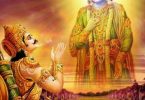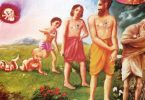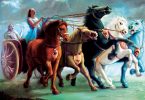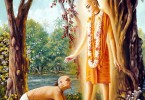Question: I wanted to know about the concept of transmigration of soul which is preached in the Bhagavad-Gita, but this transmigration is no where mentioned in the Vedas. In fact, the Vedas also say that God has no form; please clarify on the same.
Answer by Romapada Swami:
Bhagavad-gita is integral part of Vedic literature; in fact it is popularly called Gitopanisad, for it summarizes the essence of all Vedas, and has emanated directly from the lotus mouth of the Supreme Lord, as do all of the Vedas.
Most likely, by “Vedas” you are referring specifically to the four Rg, Sama, Yajur and Atharva Vedas. Bhagavad-gita, and in fact the Upanishads, Puranas, Mahabharata, samhitas etc are all part and parcel of the same body of Vedic literature. Vyasadeva divided the one Veda into many and presented them in these different divisions; the Mahabharata and the puranas are called the fifth Veda. (Please see SB 1.4.19 and 20 purport)
Srila Jiva Gosvami, in his treatise Tattva Sandarbha, analyzes this subject extensively and proves how evidence from the Puranas is as good as evidence from the four Vedas, or even superior. Jiva Goswami’s points are too elaborate to go deeply into here, but one of them explores the fact that the Vedas are not available in their entirety at present – hardly two percent of the original Vedas is extant today! Thus, if one discards these other divisions of Vedic literatures as superfluous or non-Veda, we are left with a very incomplete and fragmentary picture of the message of Vedas, indeed!
Moreover, Krishna confirms that His statements in the Gita are directly based on the Vedas and Vedanta-sutra. (BG 13.5). In fact, you will find many of its verses to be identical with texts from other Upanishads. (e.g. see BG 2.20, 29)
Having said that, there are indeed numerous references directly in the shruti shastras (i.e. 4 Vedas, Vedanta sutra and Upanishads) both on transmigration of soul and the personal feature of the Absolute Truth. Before we consider these, however, it would do well to bear the following in mind:
Negation of Form of God in the Vedas
First, a large part of the four Vedas is comprised of karma-kanda rituals, leading to promotion to heavenly realms. When we turn to the Upanishads or Brahma sutra which deal with the topics of spirit soul and the Supreme Absolute Truth, their language and style are very terse, encoding volumes of meaning in short aphorisms and thus accessible only to highly learned professors of Vedas. Besides, with a few exceptions, they mostly give only indirect pointers to the realm of Transcendence, through the classic “neti, neti” approach i.e. extensive negative description of the material realm. But negation of the non-essentials does not mean negation of the essential – the positive spiritual form. When the Supreme Brahman is described as ‘nirguna’ or ‘nirakara’, the real implication is that He has no material qualities or material form; but He does have transcendental form and qualities, inconceivable to material sense perception but directly perceived and glorified by those with spiritual vision.
Typical descriptions of the all-pervading, inexplicable and omnipotent features of the Supreme in the shruti mantras — “The Supreme walks and does not walk. He is far away, but is very near as well. He is within everything, and yet outside of everything.” — may bewilder some and cause them to conclude that a Being endowed with such characteristics must ultimately be formless. The Upanishads frequently employ such ‘double-talk’ and we find similar statements in the Gita also, (See BG 13.14, 15, 16, and 17) but their purpose is simply to portray to the conditioned soul the inconceivable, non-material nature of the Supreme; they do not in any way negate the Spiritual Form. Rather than taking these texts exclusively and out of context, when we study the Gita or any of the Upanishads in its entirety, under proper guidance, it becomes clear that there is Transcendental Form and that Krishna’s Original Form actually encompasses all such apparently contradictory and inconceivable qualities.
Some Vedic References to Transmigration of soul
In Chapter 2 of Bhagavad Gita As It Is, Srila Prabhupada quotes many references from different Upanishads discussing the nature of soul: his eternality, his repeated entanglement to fruitive actions in the embodied state and how he can attain eternal freedom and happiness by turning his attention towards the Supersoul. (Please see purports to BG 2.12, 2.17, 2.20, and 2.7) The soul is described as eternal, is neither born nor annihilated with the body and is always full with individual consciousness. Naturally, this indicates the soul’s embodiment in other forms before and after this life. In terms of Vedic Karma kanda, this would mean promotion to heavenly planets and coming back down to martya loka or hellish life, cyclically.
The soul and Supersoul are described as being seated on the same tree of material body, and due to forgetfulness of his relationship with the Supreme, the atomic soul is changing his position from one tree to another, or one body to another. (From Mundaka and Svetasvatara Upanishad, as quoted in BG 2.22 purport)
Some Vedic references to Krishna’s Transcendental Form
The Rg Veda mantra “om tad vishnoh paramam padam sada pasyanti surayah” speaks of the abode and lotus feet of Lord Vishnu. “The lotus feet of Lord Vishnu are the supreme objective of all the demigods. These lotus feet of the Lord are as enlightening as the sun in the sky.” (Rg Veda 1.22.20)
The Brahma sutra indicates that by the glance of the Supreme, the entire cosmic creation was manifested (sa aiksata) and also refers to Him by phrases such as “ananda maya”, “raso vai sah” (embodiment of bliss and reservoir of all rasas). Naturally, though implicitly, these and numerous other such statements indicate a personality – and not impersonal energy – who wills, glances, creates and maintains the material cosmos and also enjoys all varieties of transcendental mellows in His own abode. He is the Energetic, the possessor of multifarious energies/potencies. {Svetasvatara Up. Quoted in BG 3.22 purport)
There are also explicit references to the form of the Lord, covered by the dazzling effulgence of Brahmajyoti, as in this prayer from Ishopanishad (Mantras 15, 16):
“O my Lord, sustainer of all that lives, Your real face (mukham) is covered by Your dazzling effulgence. Kindly remove that covering and exhibit Yourself to Your pure devotee.
O my Lord, O primeval philosopher, maintainer of the universe, O regulating principle, destination of the pure devotees, well-wisher of the progenitors of mankind, please remove the effulgence of Your transcendental rays so that I can see Your form of bliss. (yat te rupam kalyana tamam tat te pashyami)” etc.
Thus, it is not true that the Vedas merely describe God as formless.







